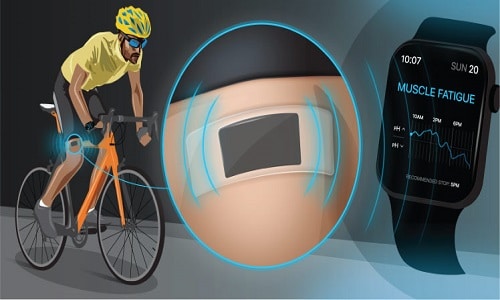Beneficial for athletes, now muscle fatigue can be checked in real-time by monitoring pH levels of sweat that occur after heavy exercise

Taking forward their 2019 research on MXene composite electrode that could absorb perspiration and detect several analytes in human sweat, including glucose and lactic acid, researchers from King Abdullah University of Science and Technology (KAUST), Saudi Arabia have now developed a prototype wearable sensor with the new MXene–hydrogel compound to track muscle movement by producing distinct electrical resistance patterns as mechanical stress increased. These patterns instantaneously change when the sensor is exposed to additional ions in the form of acidic or basic solutions.
MXenes are ultrathin nanomaterials that have high electrical conductivity and strong surface charges, making them suitable for applications in electronic devices and biosensors. The material is composed of non-toxic metals, such as titanium in combination with carbon or nitrogen atoms.
The research team has recently combined MXene sheets with hydrogels or water-filled polymers that can stretch and are compatible with human tissues. The high presence of mobile ions in the hydrogel produces strong sensitivity to the mechanical strain experienced during strenuous physical activities.
“Initially, the MXene sheets are randomly oriented within the hydrogel, but once you apply pressure to them, the sheets become more horizontally oriented,” explained Husam Alshareef, Professor of Material Science and Engineering at KAUST. “Because MXenes have a high concentration of negative charges on their surfaces, horizontal arrangements strongly affect ion movements within the hydrogel, and thus we can measure different levels of pressure change.”
This further led the research team to realise a device that can correlate pH changes in sweat to fatigue-inducing acid buildups in muscle cells.
“As we exercise and our muscles get tired, the sensor sees the new chemical environment and produces different electrical resistance versus stress curves,” says Kang Lee, a former KAUST postdoc. “By comparing these curves to reference curves for a given sensor, we can determine the pH of the sweat and how fatigued the muscle is.”
When connected with Bluetooth to other digital devices, the MXene-based sensor may benefit athletes to monitor their performance progress in real-time.
“The most serious challenge is the long-term stability of the sensor, so we’re looking at altering compositions and designs in future experiments,” says Alshareef.






